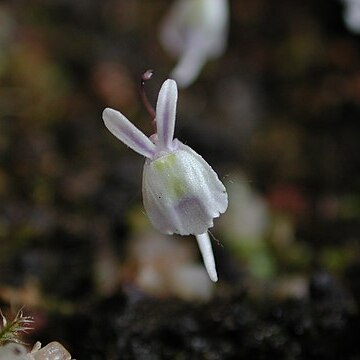Small, perennial lithophyte. Rhizoids few, capillary, simple, a few mm long, c. 0.15 mm thick. Stolons numerous, capillary, branched, up to 5 cm long or longer, 0.25 mm thick. Leaves numerous, a few from the peduncle base and others scattered on the stolons, petiolate, the lamina cuneate, obovate or flabellate, 1-6 mm wide, with apex rounded, entire or crenulate, and with numerous, dichotomously branching nerves; total length up to 15 mm. Traps numerous on the stolons and leaves, ovoid, stalked, 1-1.5 mm long, the mouth terminal with a rounded dorsal appendage, the ventral lip scarcely projecting, both dorsal appendage and ventral lip with radiating, comblike rows of stipitate glands. Inflorescence erect, simple, solitary, 2-6 cm long; peduncle terete, c. 0.6 mm thick, glabrous. Scales few or absent, similar to the bracts but smaller. Bracts basifixed, narrowly deltoid or oblong, with apex acute, c. 1 mm long. Bracteoles similar but narrower. Flowers 1-4, distant, secund, the floral internodes slightly curved; pedicels capillary, terete, 1.5-3 mm long, spreading in flower, deflexed in fruit. Calyx lobes unequal, the upper lobe approximately circular, with apex rounded, c. 2 mm long, and with a few simple nerves, the lower lobe somewhat smaller, ovate, with apex retuse, emarginate or obscurely tridentate. Corolla 10-15 mm long, white or very pale mauve with darker mauve markings on the upper lip and at the base of the lower lip; upper lip constricted near the base, the inferior part broadly ovate, the superior part cuneate, deeply divided into two divergent lobes; lower lip limb approximately circular, the base with two raised, longitudinal, transversely wrinkled crests, the apex rounded; palate margin pubescent; spur subulate, with apex acute, curved, 2-3 times as long as the lower lip. Filaments curved, c. 1 mm long, the anther thecae subdistinct. Ovary globose; style short; stigma lower lip semicircular, the upper lip much smaller, deltoid. Capsule globose, c. 2 mm long, the wall membranous, dehiscing by a single ventral, longitudinal, marginally thickened slit. Seeds transversely ellipsoid, c. 0.8 mm long. Collected in flower January to May and July to September.
More
Perennial, carnivorous herb. Leaves: blade cuneate, obovate or fan-shaped, many-veined. Traps ovoid, mouth terminal. Flowers in a simple raceme, 20-70 mm long; white, pale mauve, pale pink or blue with darker markings, palate sometimes yellow. Calyx: lobes unequal. Corolla: upper lip deeply divided into 2 divergent lobes; lower lip ± circular; spur 2-3x as long as lower lip. Flowering time July-Feb.


